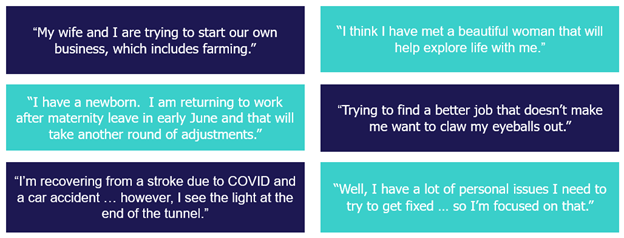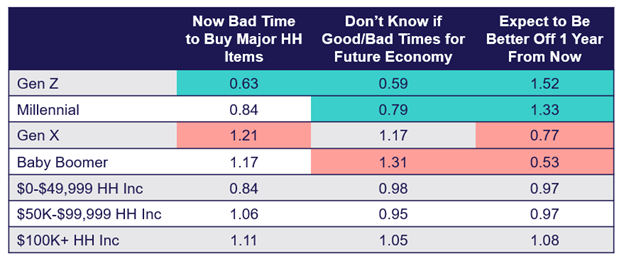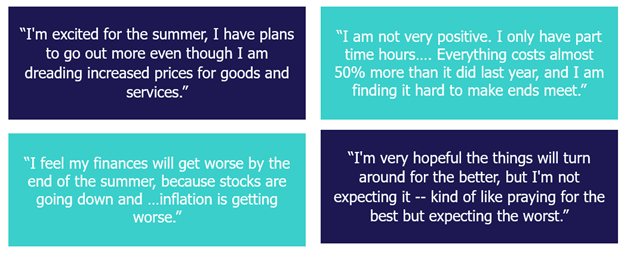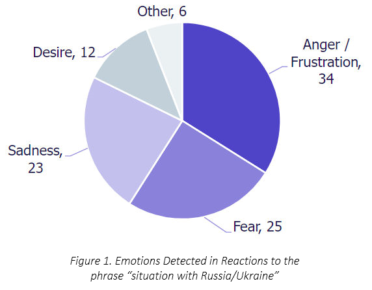Context Is Key To Dialing In Your Brand Empathy
(Part 2 of a 4–part blog series helping brands think like real people)
Welcome to our second blog post exploring how current economic and societal pressures are impacting real people and how brands need to stay close to their evolving mindsets in order to stay relevant and empathetic.
GutCheck fielded a survey in early May 2022 to better understand how people were thinking and feeling amid the current confluence of pandemic emergence and economic uncertainty. The subsequent analysis looks at the trends through the lens of Agile Human Experience Intelligence™ – a multi-dimensional approach exploring how people’s needs, emotions, personalities, and context influence their decision making. We call this approach, ‘GutCheckonomics’.
Needs In Light Of Context
In our last GutCheckonomics post which focused on Universal Needs, we saw that on average, people today across all generations and income levels are operating with deficits in the areas of esteem and love and belonging. They need to re-connect with loved ones and get some wins by achieving a goal. Given the unprecedented upheaval of the pandemic and current social, political, and economic uncertainty, it’s little wonder that connections and forward progress are so widely needed.
But is everyone experiencing today’s uncertainties in the same way? Is the context in which people seek to get these needs met the same for everyone? By context, we mean everything from macro-level societal trends to the internal and external factors present as people go about their day-to-day activities, including using and buying products and services.
Of course, the full context that a person faces can be as unique as that person. We begin by acknowledging some of these personal differences. For brands, insights professionals, or anyone working to improve empathy, it’s a useful reminder of the highs and lows people experience underneath the numbers.

Despite these individual differences, there are some patterns that arise with respect to the larger external context – the confluence of societal-level health, financial, and other societal factors.
For example, the high cost of living/inflation is named as the most important issue by all generations, parents with children at home, and those with household incomes of less than $100,000. Inflation is the second most important issue for those with incomes of $100K+ after the economy in general. In addition, 2/3 of people across all generations and income levels expect prices to continue to rise throughout the summer.
Same Context, Different Perceptions
But there are also important differences in how people perceive the current and future context. Table 1 shows which generational or income groups over- or under-index on three key measures of economic perceptions. Cells highlighted in green indicate that a subgroup has a substantially more positive perception of the current and future context, while cells highlighted in red indicate a substantially more negative perception.
Gen Z and Millennials are less likely to think now is a bad time to make major household purchases and are less uncertain about whether the future economy will bring good times or bad. Consistent with their perceptions, twice as many Gen Z and Millennials expect to be better off financially one year from now as compared to more pessimistic Gen X and Baby Boomers. Below, we provide a flavor of these divergent views.

Table 1. Index Scores for Economic Perceptions by Generation and Household Income Level
We see these sentiments articulated in people’s written responses:

Another contextual factor on the minds of some people is the ongoing war between Russia and Ukraine.

Based on coding of open-ended responses when people are asked to react to the phrase “situation with Russia/Ukraine,” the emotions of anger or frustration, fear and sadness are common across all generations and income levels.
We’ll have more to say about emotions in our next GutCheckonomics post. In the meantime, here are some implications for brands or others who want to convey empathy within today’s ever-changing context.
Brands & the U.S. Economic Context
There is no single common perception about the current and future economic context. These results show there was somewhat more optimism among younger generations versus older generations. Whether that optimism will continue remains to be seen. Brands, especially those whose target market spans younger and older generations, will need messaging with a “just right” tone – not too optimistic and not too pessimistic – to avoid creating disconnects with people who buy and use their products.
Brands & Other Contextual Factors
As the example of the Russia/Ukraine situation shows, other U.S. and world events can create strong emotions that become part of the general context in which people make purchasing, saving, and investing decisions. From natural disasters to mass violence to new virus outbreaks to controversial policy decisions – any or all can become part of the context for human behavior. As a first step toward empathy, brands should seek to understand which key elements of the macro-context are most influencing the people they serve.
GutCheck’s Agile HXI framework and the work we are doing to understand the real people shaping and being shaped by the current trends is helping brands get closer and stay closer to the people they serve. If you want your brand to thrive by innovating and communicating with empathy, let’s talk.
If you’d like to learn more about our unique GutCheckonomics™ approach, check out our hub.
Coming Soon: GutCheckonomics Part 3: Emotions – What are people sharing explicitly and what lies beneath.
Study Details: GutCheck interviewed 1,008 adults on May 2-3, 2022, via an online survey. The sample was balanced on age by sex, region, and household income to census targets for the US 18-74 population.
Written By
Want to stay up to date latest GutCheck blog posts?
Follow us on
Check Out Our Most Recent Blog Posts
When Vocation and Avocation Collide
At GutCheck, we have four brand pillars upon which we build our business. One of those is to 'lead...
Reflections on Season 1 of Gutsiest Brands
Understanding people is at the heart of market research. Sure, companies want to know what ideas...
Permission to Evolve with Miguel Garcia Castillo
(highlights from Episode #22 of the Gutsiest Brands podcast) Check out the latest lessons from our...
1-877-990-8111
[email protected]
© 2023 GutCheck is a registered trademark of Brainyak, Inc. All rights reserved.
© 2020 GutCheck is a registered trademark of Brainyak, Inc. All rights reserved.




